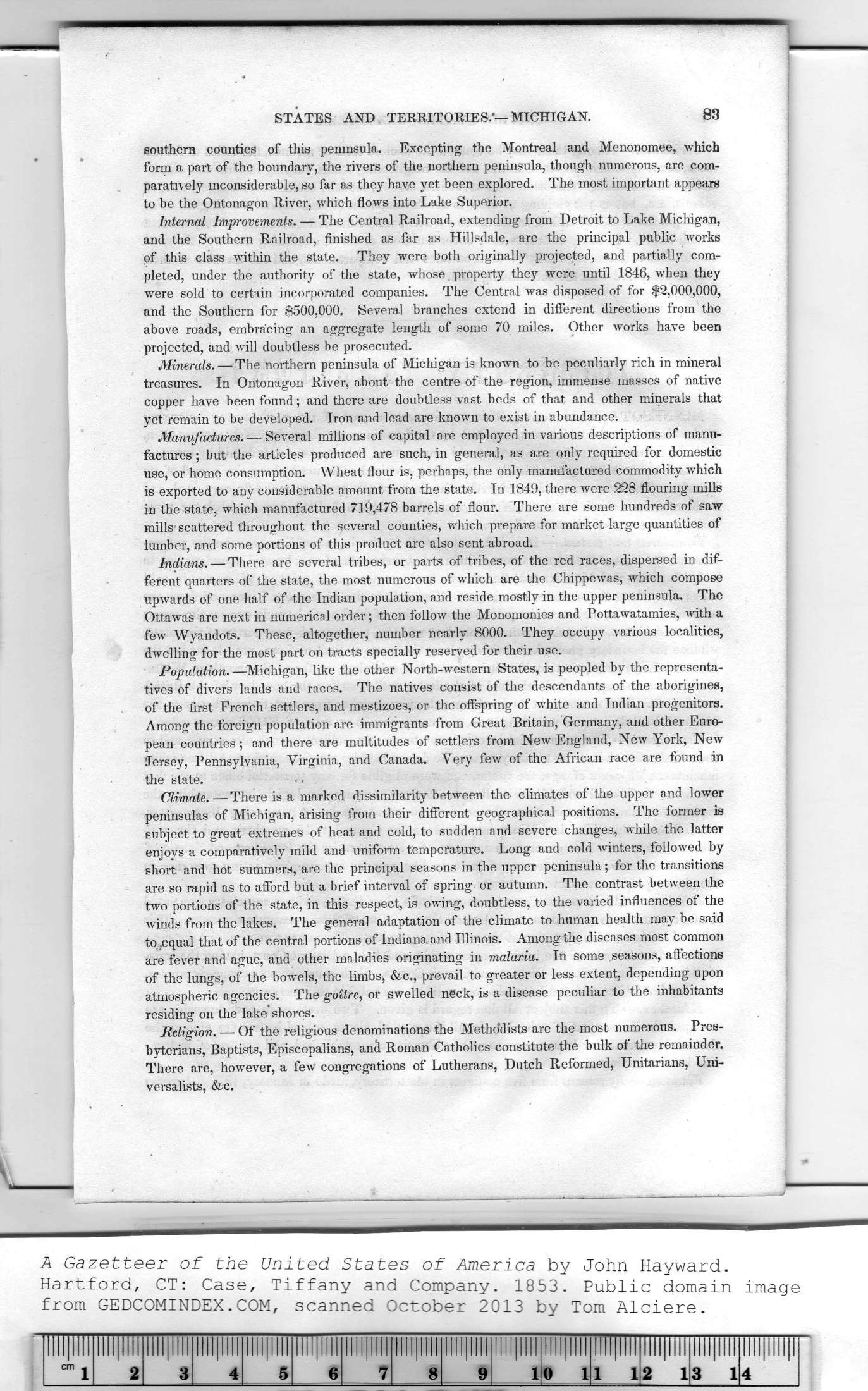|
|
Note: Ctrl and + increases the font size of the text below, Ctrl and - decreases it, and Ctrl and 0 resets it to default size.
STATES AND TERRITORIES/—MICHIGAN. 83
southern counties of this peninsula. Excepting the Montreal and Menonomee, which
form a part of the boundary, the rivers of the northern peninsula, though numerous, are com-
paratively inconsiderable, so far as they have yet been explored. The most important appears
to be the Ontonagon River, which flows into Lake Superior.
Internal Improvements. — The Central Railroad, extending from Detroit to Lake Michigan,
and the Southern Railroad, finished as far as Hillsdale, are the principal public works
of this class within the state. They were both originally projected, and partially com-
pleted, under the authority of the state, whose property they were until 1846, when they
were sold to certain incorporated companies. The Central was disposed of for $2,000,000,
and the Southern for $500,000. Several branches extend in different directions from the
above roads, embracing an aggregate length of some 70 miles. Other works have been
projected, and will doubtless be prosecuted.
Minerals. — The northern peninsula of Michigan is known to be peculiarly rich in mineral
treasures. In Ontonagon River, about the centre of the region, immense masses of native
copper have been found; and there are doubtless vast beds of that and other minerals that
yet remain to be developed. Iron and lead are known to exist in abundance.
Manufactures. — Several millions of capital are employed in various descriptions of manu-
factures ; but the articles produced are such, in general, as are only required for domestic
use, or home consumption. Wheat flour is, perhaps, the only manufactured commodity which
is exported to any considerable amount from the state. In 1849, there were 228 flouring mills
in the state, which manufactured 719,478 barrels of flour. There are some hundreds of saw
mills' scattered throughout the several counties, which prepare for market large quantities of
lumber, and some portions of this product are also sent abroad.
Indians. — There are several tribes, or parts of tribes, of the red races, dispersed in dif-
ferent quarters of the state, the most numerous of which are the Chippewas, which compose
upwards of one half of the Indian population, and reside mostly in the upper peninsula. The
Ottawas are next in numerical order; then follow the Monomonies and Pottawatamies, with a
few Wyandots. These, altogether, number nearly 8000. They occupy various localities,
dwelling for the most part on tracts specially reserved for their use.
Population. —Michigan, like the other North-western States, is peopled by the representa-
tives of divers lands and races. The natives consist of the descendants of the aborigines,
of the first French settlers, and mestizoes, or the offspring of white and Indian progenitors.
Among the foreign population are immigrants from Great Britain, Germany, and other Euro-
pean countries; and there are multitudes of settlers from New England, New York, New
Jersey, Pennsylvania, Virginia, and Canada. Very few of the African race are found in
the state.
Climate. — There is a marked dissimilarity between the climates of the upper and lower
peninsulas of Michigan, arising from their different geographical positions. The former is
subject to great extremes of heat and cold, to sudden and severe changes, while the latter
enjoys a comparatively mild and uniform temperature. Long and cold winters, followed by
short and hot summers, are the principal seasons in the upper peninsula; for the transitions
are so rapid as to afford but a brief interval of spring or autumn. The contrast between the
two portions of the state, in this respect, is owing, doubtless, to the varied influences of the
winds from the lakes. The general adaptation of the climate to human health may be said
to .equal that of the central portions of Indiana and Illinois. Among the diseases most common
are fever and ague, and other maladies originating in malaria. In some seasons, affections
of the lungs, of the bowels, the limbs, &c., prevail to greater or less extent, depending upon
atmospheric agencies. The goitre, or swelled neck, is a disease peculiar to the inhabitants
residing on the lake shores.
Religion. — Of the religious denominations the Metho'dists are the most numerous. Pres-
byterians, Baptists, Episcopalians, anl Roman Catholics constitute the bulk of the remainder.
There are, however, a few congregations of Lutherans, Dutch Reformed, Unitarians, Uni-
versalists, &c.
|
IIIPI |
lllllllll |
lll!|l!ll |
lllllllll |
lllllllll |
lllllllll |
lllllllll |
lllllllll |
llll|llll |
lllllllll |
lllllllll |
lllllllll |
lllllllll |
lllllllll |
lllllllllll |
|
cm j |
2 |
3 |
4 |
5 |
6 |
7 |
8 |
9 |
1 |
0 1 |
1 1 |
2 1 |
CO |
4 |
|
